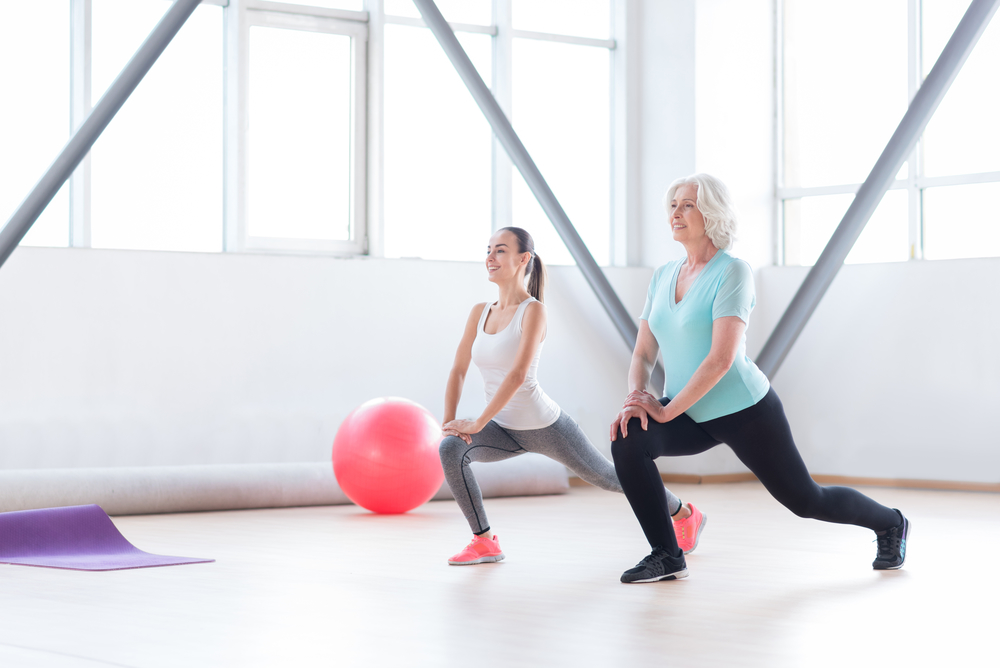How Women Can Keep Their Hips & Knees Healthy At All Stages of Life

By M. Brian Polsky, M.D., Orthopaedic Associates of Central Maryland care center
Any woman who has experienced a knee or hip injury understands the ill effects on mobility and the hindrance on daily living. Women at all stages of life are susceptible to injury from athletics, overuse and aging.
Because the female pelvis is aligned differently than a male’s pelvis, it can put more stress on the muscles around the hips and knees. It takes a bit more effort for women to avoid injuries because of this fact of anatomy.
Injury Prevention in Younger Women and Athletes – Adolescents Through the 30s
Younger female athletes and active women are prone to muscle strains and sprains around the knees and hips as well as cartilage tears in the labrum (hip) or the ACL and meniscus in knees. These injuries are becoming increasingly common in young female athletes with the higher demands of sports and increased frequency of practice and competition.
In this age group, prevention of injuries to hips and knees revolves around increasing and improving both flexibility and strength, especially of the hip flexor and quad muscles around the knees. Because many young athletes are multisport competitors and play year round, strengthening and conditioning of the muscles should be a focus for female athletes to avoid potential injury.
Injury Treatment
Minor injuries such as strains and tears to the labrum and muscles around the knee can be successfully treated early on by limiting activity for several weeks as well as taking the appropriate dosage of anti-inflammatories, taping, and using the RICE method – Rest, Ice, Compression, and Elevate.
If this type of treatment is not successful at alleviating the injury, it may be necessary to be seen by an orthopaedic specialist.
Injuries and Issues in Older Women
As women age, issues such as joint pain and stiffness, as well as arthritis, begin to emerge. Many women also begin to experience problems with muscle fatigue and overall strength as they enter into their 50s and 60s because of reduction in estrogen production with menopause. Diminished muscle strength and weakness due to a hormonal imbalance is common in mature women and is often accompanied by tight knee muscles and hip pain. Arthritic damage in a joint also affects the muscles and tendons around the joint, causing pain, stiffness and even disability.
For Older Women, Prevention and Strengthening is Key
Older women who have healthy knee and hip joints, but experience pain, stiffness and muscle weakness should start a stretching and strengthening program.
- Many gyms and community centers offer these types of conditioning programs.
- Physical therapy may also be indicated if pain and muscle fatigue becomes increasingly worse.
- Gentle activities such as yoga and walking can often work wonders on joints and muscles that are fatigued or stiff. These exercises are low impact and have many benefits on an individual’s overall health.
- For arthritic joints where cartilage is wearing out and bone is rubbing on bone, we offer several non-surgical therapies including injection therapy and pain management as well as bracing to provide support and strength to weaker knee joints.
As orthopaedic physicians, our goal is to treat hip and knee issues non-surgically when possible to return athletes to their previous level of competition or better, as well as to restore function and mobility for older women so they can continue to enjoy activities without pain in their joints.
When Non-Surgical Options are Exhausted, Minimally Invasive Surgical Procedures are Available
When surgery is needed – either for a traumatic injury in athletes or for women who experience arthritis or joint deterioration – there are a number of minimally invasive surgical options. Injuries that include a torn meniscus in the knee or torn labrum in the hip, for example, usually require surgical intervention as treatment. In addition, arthritic joints that have become disabling may also require surgery to restore mobility as well as quality of life to patients experiencing chronic pain and the reduced ability to walk or move around as usual. Surgery options include:
- Arthroscopic surgery or arthroscopy uses a special camera-like instrument called an arthroscope to enable the orthopaedic surgeon to see inside a joint without having to open the joint up. This advanced technique allows surgeons to diagnose and repair conditions at the same time. Arthroscopic procedures only require several very small incisions.
- Joint replacement surgery is often indicated when the protective cartilage that lines a joint surface wears away and joint pain and movement limitations inhibit quality of life. Our surgeons are highly experienced in the most advanced minimally invasive joint replacement techniques and have performed thousands of joint replacement surgeries including partial joint and total joint replacement.
Minimally invasive procedures offer patients many important benefits including less pain, small incisions, a quicker recovery and fewer post-surgical complications.
One of the great strengths of CAO – and most individual care centers – is that we offer prevention and treatments for every orthopaedic sub-specialty, including surgical and non-surgical treatments for the entire musculoskeletal system.
M. Brian Polsky, M.D., is a board certified and fellowship trained orthopaedic surgeon specializing in orthopaedic surgery, minimally invasive arthroscopic surgery, sports medicine and joint replacement at the Orthopaedic Associates of Central Maryland care center. Dr. Polsky also serves as a Clinical Instructor in the Department of Orthopaedics at the University of Maryland and regularly publishes new research in peer-reviewed medical journals.

